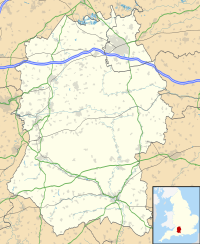
Stephen, often referred to as Stephen of Blois, was King of England from 22 December 1135 to his death in 1154. A younger son of the Count of Blois, he was Count of Boulogne jure uxoris from 1125 until 1147 and Duke of Normandy from 1135 until 1144. His reign was marked by the Anarchy, a civil war with his cousin and rival, the Empress Matilda, whose son, Henry II, succeeded Stephen as the first of the Angevin kings of England.

The Anarchy was a civil war in England and Normandy between 1135 and 1153, which resulted in a widespread breakdown in law and order. The conflict was a succession crisis precipitated by the accidental death by drowning of William Adelin, the only legitimate son of Henry I, in the sinking of the White Ship in 1120. Henry's attempts to install his daughter, the Empress Matilda, as his successor were unsuccessful and on Henry's death in 1135, his nephew Stephen of Blois seized the throne with the help of Stephen's brother, Henry of Blois, the Bishop of Winchester. Stephen's early reign was marked by fierce fighting with English barons, rebellious Welsh leaders and Scottish invaders. Following a major rebellion in the south-west of England, Matilda invaded in 1139 with the help of her half-brother Robert of Gloucester.

Malmesbury Abbey, at Malmesbury in Wiltshire, England, is a religious house dedicated to Saint Peter and Saint Paul. It was one of the few English houses with a continuous history from the 7th century through to the Dissolution of the Monasteries.
William of Malmesbury was the foremost English historian of the 12th century. He has been ranked among the most talented English historians since Bede. Modern historian C. Warren Hollister described him as "a gifted historical scholar and an omnivorous reader, impressively well versed in the literature of classical, patristic, and earlier medieval times as well as in the writings of his own contemporaries. Indeed William may well have been the most learned man in twelfth-century Western Europe."

Glastonbury Abbey was a monastery in Glastonbury, Somerset, England. Its ruins, a grade I listed building and scheduled ancient monument, are open as a visitor attraction.
Geoffrey Rufus, also called Galfrid Rufus was a medieval Bishop of Durham and Lord Chancellor of England.
Roger le Poer was a medieval Lord Chancellor from 1135 until 1139 for King Stephen of England. The son of a powerful bishop, Roger owed his position to his family connections. He lost his office when his father and other relatives lost power. Arrested along with his father, Roger was used to secure the surrender of a castle held by his mother and then disappeared from history.

Henry of Blois, often known as Henry of Winchester, was Abbot of Glastonbury Abbey from 1126, and Bishop of Winchester from 1129 to his death. He was a younger son of Stephen Henry, Count of Blois by Adela of Normandy, daughter of William the Conqueror and Matilda of Flanders. Thus, he was a younger brother of Stephen, King of England.

Wiltshire is a historic county located in the South West England region. Wiltshire is landlocked and is in the east of the region.
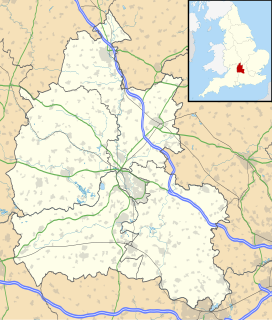
Wallingford Castle was a major medieval castle situated in Wallingford in the English county of Oxfordshire, adjacent to the River Thames. Established in the 11th century as a motte-and-bailey design within an Anglo-Saxon burgh, it grew to become what historian Nicholas Brooks has described as "one of the most powerful royal castles of the 12th and 13th centuries". Held for the Empress Matilda during the civil war years of the Anarchy, it survived multiple sieges and was never taken. Over the next two centuries it became a luxurious castle, used by royalty and their immediate family. After being abandoned as a royal residence by Henry VIII, the castle fell into decline. Refortified during the English Civil War, it was eventually slighted, i.e. deliberately destroyed, after being captured by Parliamentary forces after a long siege. The site was subsequently left relatively undeveloped, and the limited remains of the castle walls and the considerable earthworks are now open to the public.

Bedford Castle was a large medieval castle in Bedford, England. Built after 1100 by Henry I, the castle played a prominent part in both the civil war of the Anarchy and the First Barons' War. The castle was significantly extended in stone, although the final plan of the castle remains uncertain. Henry III of England besieged the castle in 1224 following a disagreement with Falkes de Breauté; the siege lasted eight weeks and involved an army of as many as 2,700 soldiers with equipment drawn from across England. After the surrender of the castle, the king ordered its destruction.

Alexander of Lincoln was a medieval English Bishop of Lincoln, a member of an important administrative and ecclesiastical family. He was the nephew of Roger of Salisbury, a Bishop of Salisbury and Chancellor of England under King Henry I, and he was also related to Nigel, Bishop of Ely. Educated at Laon, Alexander served in his uncle's diocese as an archdeacon in the early 1120s. Unlike his relatives, he held no office in the government before his appointment as Bishop of Lincoln in 1123. Alexander became a frequent visitor to King Henry's court after his appointment to the episcopate, often witnessing royal documents, and he served as a royal justice in Lincolnshire.

Nigel was an Anglo-Norman Bishop of Ely. He came from an ecclesiastical family; his uncle Roger of Salisbury was a bishop and government minister for King Henry I, and other relatives also held offices in the English Church and government. Nigel owed his advancement to his uncle, as did Nigel's probable brother Alexander, who like Nigel was advanced to episcopal status. Nigel was educated on the continent before becoming a royal administrator. He served as Treasurer of England under King Henry, before being appointed to the see, or bishopric, of Ely in 1133. His tenure was marked by conflicts with the monks of his cathedral chapter, who believed that Nigel kept income for himself that should properly have gone to them.
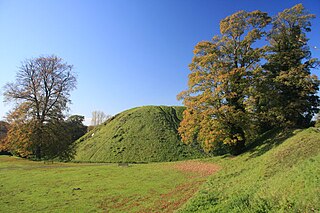
Thetford Castle is a medieval motte and bailey castle in the market town of Thetford in the Breckland area of Norfolk, England. The first castle in Thetford, a probable 11th century Norman ringwork called Red Castle, was replaced in the 12th century by a much larger motte and bailey castle on the other side of the town. This new castle was largely destroyed in 1173 by Henry II, although the huge motte, the second largest man-made mound in England, remained intact. The motte, recognised as a scheduled monument, now forms part of a local park, and the remains are known variously as Castle Hill, Castle Mound and Military Parade.

Worcester Castle was a Norman fortification built between 1068 and 1069 in Worcester, England by Urse d'Abetot on behalf of William the Conqueror. The castle had a motte-and-bailey design and was located on the south side of the old Anglo-Saxon city, cutting into the grounds of Worcester Cathedral. Royal castles were owned by the king and maintained on his behalf by an appointed constable. At Worcester that role was passed down through the local Beauchamp family on a hereditary basis, giving them permanent control of the castle and considerable power within the city. The castle played an important part in the wars of the 12th and early 13th century, including the Anarchy and the First Barons' War.
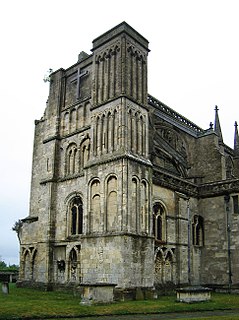
Malmesbury is a town and civil parish in Wiltshire, England. As a market town it became prominent in the Middle Ages as a centre for learning focused on and around Malmesbury Abbey, the bulk of which forms a rare survival of the dissolution of the monasteries. Once the site of an Iron Age fort, in the Anglo-Saxon period it became the site of a monastery famed for its learning and one of Alfred the Great's fortified burhs for defence against the Vikings. Æthelstan, the first king of all England, was buried in Malmesbury Abbey when he died in 939.

The Old Bell is a hotel and restaurant on the edge of the Cotswolds in Malmesbury, Wiltshire, England. Built on the remains of outbuildings of Malmesbury Abbey, it lays claim to being the oldest existing hotel in England, standing on foundations dated to 1220, and is a Grade I listed building. It is located in Abbey Row adjacent to the abbey, which was built to accommodate scholars studying at the abbey. The bell of the inn sign refers to St Aldhelm's bell, the great bell in a peal of ten that once hung in the former west end tower of the abbey church, noted by John Leland's Itinerary and in William Camden's Britannia.
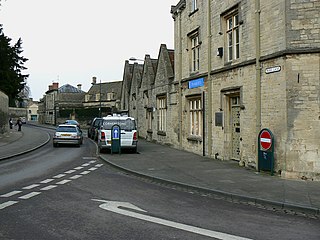
Cirencester Castle was a castle in the town of Cirencester in Gloucestershire, England.
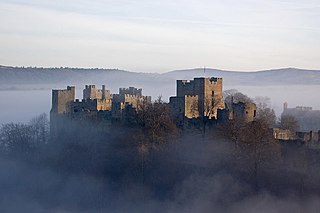
Pain fitzJohn was an Anglo-Norman nobleman and administrator, one of King Henry I of England's "new men", who owed their positions and wealth to the king.

Josce de Dinan was an Anglo-Norman nobleman who lived during and after the civil war between King Stephen of England and his cousin Matilda over the throne of England. He was a landholder in the Welsh Marches when he was married by Stephen to the widow of Pain fitzJohn, a union that gave Josce control of Ludlow Castle. Control of the castle was contested by other noblemen, and the resulting warfare between the nobles forms the background to a late medieval romance known as Fouke le Fitz Waryn, which is mainly concerned with the actions of Josce's grandson, but also includes some material on Josce's lifetime. Josce eventually lost control of Ludlow and was granted lands in compensation by Matilda and her son, King Henry II of England, who succeeded Stephen in 1154.
